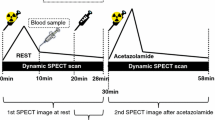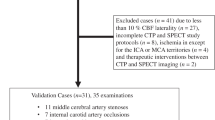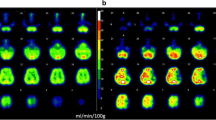Abstract
To evaluate the usefulness of a combination of linearization and seatter-attenuation correction on99mTc-bicisate (ECD)-single photon emission tomographic (SPECT) images, both cerebral blood flow (CBF)-positron emission tomographic (PET) images and ECD-SPECT images from fifteen patients with chronic cerebral infarction were acquired. We measured radioactivity counts in regions of interest (ROIs) on all sets of both images and obtained a 2D scattered graph between ECD-SPECT and CBF-PET data. To evaluate diagnostic accuracy, the sensitivity, specificity and accuracy of ECD-SPECT images were calculated by means of discriminant analysis. The same analysis was also performed on the ECD-SPECT images corrected by a combination of linearization and scatter-attenuation correction. An overall nonlinear relationship was observed between ECD-SPECT and CBF-PET. The sensitivity, specificity, and accuracy of ECD-SPECT images were 69.6%, 91.4% and 73.0%, and those of ECD images corrected by the combination of linearization and scatter-attenuation correction were 79.5%, 95.7% and 82.0% respectively. The clinically diagnostic accuracy of ECD-SPECT images corrected by the combined method apparently increased. So that the linearization with the scatter-attenuation method is useful for improving the diagnostic accuracy of ECD-SPECT images.
Similar content being viewed by others
References
Kung HF, Guo YZ, Yu CC, Billings J, Subramanyam V, Calabrese JC. New brain perfusion imaging agents based on Tc-99m bis-(aminoethanethiol) complexes: stereoisomers and biodistribution.J Med Chem 1989; 32: 433–437.
Walovitch RC, Hill TC, Garrity ST, Cheesman EH, Burgess BA, O’Leary DH, et al. Characterization of technetium-99m-i., i.-ECD for brain perfusion imaging, part 1: pharmacology of technetium-99m ECD in nonhuman primates.J Nucl med 1989; 30: 1892–1901.
Kundsen GM, Andersen AR, Somnier FE, Videbaek C, Hasselbalch S, Paulson OB: Brain extraction and distribution of Tc-99m bicisate in humans and in rats.J Cereb Blood Flow Metab 1994; 14: Suppl 1): S12-S18.
Crone C. The permeability of capillaries in various organs as determined by use of the “indicator diffusion” method.Acta Physiol Scand 1963; 58: 292–305.
Raichle ME, Eichling JO, Straatmann MG, Welch MJ, Larson KB, Ter-Pogossian MM. Blood-brain barrier permeability of C-11-labeled alcohols and O-15-labeled water.Am J Physiol 1976; 230: 543–552.
Yonekura Y, Tsuchida T, Sadato N, Nishizawa S, Iwasaki Y, Mukai T, et al. Brain perfusion SPECT with Tc-99m-bicisate: comparison with PET measurement and linearization based on permeability-surface area product model.J Cereb Blood Flow Metab 1994; 14 (Suppl 1): S58-S65.
Tsuchida T, Yonekura Y, Nishizawa S, Sadato N, Tamaki N, Fujita T, et al. Nonlinearity correction of brain perfusion SPECT based on permeability-surface area product model.J Nucl Med 1996; 37: 1237–1241.
Iida H, Miura S, Kanno I, Murakami M, Takahashi K, Uemura K, et al. Design and evaluation of Headtome 4, a whole-body positron emission tomograph.IEEE Trans Nucl Sci 1989; 36: 1006–1010.
Kanno I, Uemura K, Miura S, Miura Y. Headtome: A hybrid emission tomograph for single photon and positron emission imaging of the brain.J Comput Assist Tomogr 1981; 5: 216–226.
Ardekani BA, Braun M, Hutton BF, Kanno I, Iida H. A fully automatic multimodality image registration algorithm.J Comput Assist Tomogr 1995; 19: 615–623.
Yamaguchi T, Kanno I, Uemura K, Shishido F, Inugami A, Ogawa T, et al. Reduction in regional cerebral metabolic rate of oxygen during human aging.Stroke 1986; 17: 1220–1228.
Ogawa K, Ichihara T, Kubo A. Accurate scatter correction in single photon emission CT.Ann Nucl Med 1994; 7: 145–150.
Lars F, Allan RA, Niels AL, Søren H, Mogens D. Retention of Tc-99m bicisate in the human brain after intracarotid injection.J Cereb Blood Flow Metab 1994; 14: S19-S27.
Lassen NA, Sperling B.99mTc-bicisate relatively images CBF in chronic brain diseases but fails to show reflow hyperemia in subacute stroke: report of a multicenter trail of 105 cases comparing133Xe and99mTc-bicisate (ECD, neurolite) measured by SPECT on same day.J Cereb Blood Flow Metab 1994; 14: S44-S48.
Iida H, Narita Y, Kado H, Kashikura A, Sugawara S, Shoji Y, et al. Effects of scatter and attenuation correction on quantitative assessment of regional cerebral blood flow with SPECT.J Nucl Med 1998; 39: 181–189.
Author information
Authors and Affiliations
Corresponding author
Rights and permissions
About this article
Cite this article
Kado, H., Iida, H., Kimura, H. et al. Brain perfusion SPECT study with99mTc-bicisate: Clinical pitfalls and improved diagnostic accuracy with a combination of linearization and scatter-attenuation correction. Ann Nucl Med 15, 123–129 (2001). https://doi.org/10.1007/BF02988602
Received:
Accepted:
Issue Date:
DOI: https://doi.org/10.1007/BF02988602




